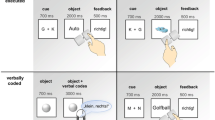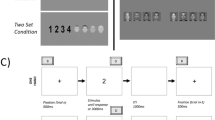Abstract
Recent findings indicate that two distinct mechanisms can contribute to a Simon effect: a visuomotor information transmission on the one hand and a cognitive code interference on the other hand (see for e.g., Wiegand & Wascher, in Journal of Experimental Psychology: Human Perception and Performance 2005a). Furthermore, it was proposed that the occurrence of one or the other mechanism strongly depends on the way responses are coded. Visuomotor information transmission seems to depend on a correspondence between stimulus position and spatial anatomical status of the effector, whereas cognitive code interference is thought to be based on relative response location codes. To further test the spatial anatomic coding hypothesis, three experiments were conducted, in which the Simon effect with unimanual responses was investigated for horizontal (Experiment 1 and 2) and vertical (Experiment 3) stimulus–response (S–R) relations. Based on the finding of a decreasing effect function (indicating the presence of visuomotor information transmission) for horizontal and vertical S–R relations, it was concluded that visuomotor information transmission occurs whenever there is an overlap between the spatial stimulus feature and parameters of the motor representation of the response. Furthermore, the specific motor representation seems to be task dependent, that is, it entails those response parameters that clearly differentiate between the two response alternatives in a given task situation.



Similar content being viewed by others
Notes
It should be noted, that the effect function does not necessarily decrease linearly. In several experiments, an initially increasing and later decreasing (i.e., inverted u-shaped or j-shaped) effect function has been reported (e.g., Wascher et al., 2001). This initial increase for very fast RTs presumably shows that the automatic response activation takes some time to build up (i.e., to reach maximum influence)
References
Ansorge, U. (2003a). Influences of response-activating stimuli and passage of time on the Simon effect. Psychological Research, 67(3), 174–183.
Ansorge, U. (2003b). Spatial Simon effects and compatibility effects induced by observed gaze direction. Visual Cognition, 10(3), 363–383.
Ansorge, U., & Wühr, P. (2004). A response-discrimination account of the Simon effect. Journal of Experimental Psychology: Human Perception and Performance, 30(2), 365–377.
De Jong, R., Liang, C.-C., & Lauber, E. (1994). Conditional and unconditional automaticity: A dual-process model of effects of spatial stimulus–response correspondence. Journal of Experimental Psychology: Human Perception & Performance, 20(4), 731–750.
Eimer, M., Hommel, B., & Prinz, W. (1995). S–R compatibility and response selection. Acta Psychologica, 90(1–3), 301–313.
Fitts, P. M., & Seeger, C. M. (1953). S-R compatibility: spatial characteristics of stimulus and response codes. Journal of Experimental Psychology, 46, 199–210.
Guiard, Y. (1983). The lateral coding of rotations: A study of the Simon effect with wheel–rotation responses. Journal of Motor Behavior, 15(4), 331–342.
Hommel, B. (1993). The relationship between stimulus processing and response selection in the Simon task: Evidence for a temporal overlap. Psychological Research, 55(4), 280–290.
Hommel, B. (1994). Spontaneous decay of response-code activation. Psychological Research, 56(4), 261–268.
Hommel, B., Muesseler, J., Aschersleben, G., & Prinz, W. (2001). The theory of event coding (TEC): A framework for perception and action planning. Behavioral & Brain Sciences, 24(5), 849–937.
Kornblum, S., Hasbroucq, T., & Osman, A. (1990). Dimensional overlap: cognitive basis for stimulus–response compatibility-A model and taxonomy. Psychological Review April, 97(2), 253–270.
Proctor, R. W., Vu, K.-P. L., & Nicoletti, R. (2003). Does right–left prevalence occur for the Simon effect? Perception & Psychophysics, 65(8), 1318–1329.
Ratcliff, R. (1979). Group reaction time distributions and an analysis of distribution statistics. Psychological Bulletin, 86(3), 446–461.
Simon, J. R., & Rudell, A. P. (1967). Auditory S–R compatibility—effect of an irrelevant cue on information processing. Journal of Applied Psychology, 51(3), 300–304.
Stuermer, B., Leuthold, H., Soetens, E., Schroeter, H., & Sommer, W. (2002). Control over location-based response activation in the Simon task: Behavioral and electrophysiological evidence. Journal of Experimental Psychology: Human Perception & Performance, 28(6), 1345–1363.
Tagliabue, M., Zorzi, M., Umiltà, C., & Bassignani, F. (2000). The role of long-term-memory and short-term-memory links in the Simon effect. Journal of Experimental Psychology: Human Perception & Performance, 26(2), 648–670.
Valle-Inclán, F., & Redondo, M. (1998). On the automaticity of ipsilateral response activation in the Simon effect. Psychophysiology, 35(4), 366–371.
Vallesi, A., Mapelli, D., Schiff, S., Amodio, P., & Umiltà, C. (2005). Horizontal and vertical Simon effect: different underlying mechanisms? Cognition, 96, B33-B43.
Wascher, E. (2005). The timing of stimulus localization and the Simon Effect. An EEG-study. Experimental Brain Research, 163(4), 430–439.
Wascher, E., Verleger, R., & Wauschkuhn, B. (1996). In pursuit of the Simon effect: The effect of S–R compatibility investigated by event-related potentials. Journal of Psychophysiology, 10(4), 336–346.
Wascher, E., Schatz, U., Kuder, T., & Verleger, R. (2001). Validity and boundary conditions of automatic response activation in the Simon task. Journal of Experimental Psychology: Human Perception & Performance, 27(3), 731–751.
Wiegand, K., & Wascher, E. (2005a). Dynamic aspects of stimulus-response correspondence: Evidence for two mechanisms involved in the Simon effect. Journal of Experimental Psychology: Human Perception and Performance, 31(3), 453–464.
Wiegand, K., & Wascher, E. (2005b). The Simon Effect for vertical S-R relations: Changing the mechanism by randomly varying the S–R mapping rule? Psychological Research, in press
Zorzi, M., Mapelli, D., Rusconi, E., & Umiltà, C. (2003). Automatic spatial coding of perceived gaze direction is revealed by the Simon effect. Psychonomic Bulletin & Review, 10(2), 423–429.
Author information
Authors and Affiliations
Corresponding author
Rights and permissions
About this article
Cite this article
Wiegand, K., Wascher, E. Response coding in the Simon task. Psychological Research 71, 401–410 (2007). https://doi.org/10.1007/s00426-005-0027-1
Received:
Accepted:
Published:
Issue Date:
DOI: https://doi.org/10.1007/s00426-005-0027-1




